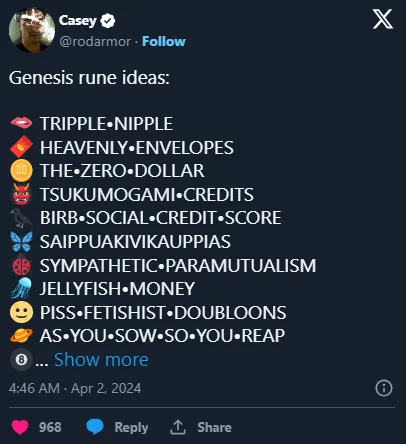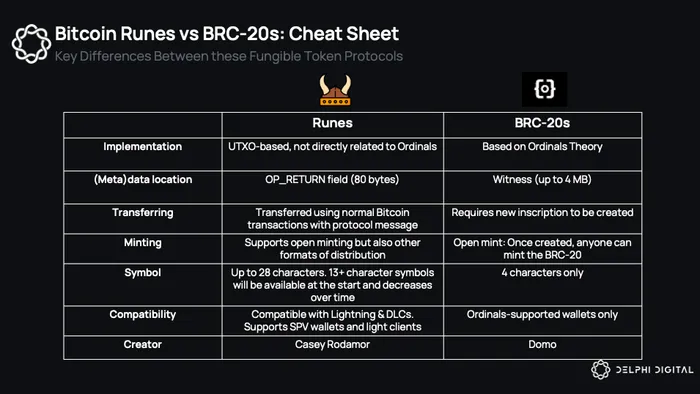As the halving approaches, speculators eagerly anticipate the launch of Runes. Drawing significant mindshare on CT, there’s much confusion and misinformation surrounding this new token standard. Even more so exacerbated by a myriad of unaffiliated protocols implementing “Rune” in their name and token.
So, let’s shed some light on this.
What are Runes?
Casey Rodarmor, the developer behind Ordinal Theory, is building yet another novel innovation – a fungible token standard for Bitcoin called the Runes Protocol. As a meta protocol, the Runes protocol is not a token itself – but, quoting Casey on his podcast “a venue for people to create shitcoins” on Bitcoin.
Tokens created using this token standard are called Runes. Unlike BRC-20s, Runes are a fungible token standard meaning each Rune is interchangeable. The best analogy here are ERC-20 tokens on Ethereum. The Runes token standard is similar yet simpler and created for the Bitcoin Network.
High Level Overview
- Runes Protocol along with Runes launch at the halving block, ~ April 19
- Runes balances are stored in Bitcoin UTXOs
The Runes protocol expands UTXOs to store both Bitcoin and Rune balances adopting Bitcoin’s security framework. As a result, users can create and trade Runes making regular Bitcoin transactions.
- Runes 0-9 are hardcoded to guarantee fair launches
An important nuance. Numerous protocols are racing to be amongst the first to launch their own Rune token using creative gamification models and promising airdrops. Be cautious of disingenuous marketing from projects claiming to be the first Runecoin; they can at best secure & etch the 11th Rune.
The Genesis Rune, Rune 0, will have an open mint starting at this halving and ending at the next halving in ~4 years. Each mint receives one Genesis Rune with the divisibility being zero.
- Initially, only 13 or more characters are available as Rune names
Approx. every 4 months, token names with one less character become available. The maximum name length is 28 characters. To prevent front-running, a commit-reveal scheme is implemented. The unlock schedule for token names can be found here. Anyways, buckle up for crazy token names:

- OP_Return field is used to create Runes
This makes each Rune name unique. Additionally, each token will have a single Unicode code point as a currency symbol.
Will Runes dethrone BRC-20s?
With a total market cap of $2.65 billion, BRC-20s boast a significant market size on Bitcoin. The Rune narrative is primarily driven by speculators betting on Runes to replace BRC-20s and becoming the new widely used token standard on Bitcoin.
Are Runes the superior token standard?
The differences between the two are stark, as we highlighted in our deep dive on Ordinals and Runes:

Instead of using witness data, Runes utilize the OP_RETURN field streamlining the process for creating tokens. Users can etch (deploy), mint, and transfer Runes making regular bitcoin transactions made possible by Runestones.
Runestones are Rune protocol messages that store transfer instructions in Bitcoin’s unspent transaction outputs, short UTXOs. These transfer instructions determine how Runes are transferred within the output, such as target address and amount being transferred. By default, the Rune balance on the input UTXO is destroyed when being transferred to a new UTXO.
This is a more network friendly approach than the BRC-20 standard which currently creates lots of unused UTXOs cluttering the network. Another drawback of BRC-20s is the necessity to create a new inscription for every token transfer.
Runes offer greater flexibility in their creation as well. They can feature an open mint, fair distribution, and users also have the option to mint the entire supply to a single address (just like ERC-20s). On the other hand, BRC-20s are limited to an open mint.
More importantly, BRC-20 inscriptions are more vulnerable to frontrunning. That’s because anyone can see your inscription transaction in the mempool and decide to frontrun it by paying higher transaction fees – especially frustrating when trying to deploy a new token. Contrarily, Runes try to prevent front-running by using a commit-reveal scheme. On a higher level, this allows users to privately commit to a transaction. Details are only revealed shortly before confirmation, reducing the time window for front-running significantly.
Lastly, Runes support compatibility with SPV wallets and Bitcoin L2s using the UTXO model. So in theory, implementation with lightweight wallets and integration with the Lightning Network for faster and cheaper transactions is possible. Emphasis on in theory because although the interoperability is there, the infra has to be developed first.
Some FUD.
On paper, Runes solve a lot of issues that BRC-20s face when it comes to UX and compatibility. Yet, I’m cautious to subscribe to the idea that Runes will indisputably replace BRC-20s.
To enable protocol upgrades and ensure clients stay in sync, Casey added what he calls the Cenotaph model to the Runes protocol. Cenotaphs are malformed Runestones created by bad inputs. When included in a transaction, Runes associated with Cenotaphs are burned or rendered unusable.
A point of contention since it introduces the risk of unintentionally losing your Runes. For instance, if you interact with an app creating a Runes transaction and it accidentally produces a Cenotaph, you may lose all Rune balances stored in the same UTXO.
Serious or insignificant risk? Hard to tell before the protocol goes live but something to keep in mind. Casey addressed these concerns in this thread – TLDR: In his opinion, the risk is negligible. Regardless of significance, steering clear of untested third-party services post Runes launch is a good way to minimize risk.
Fwiw, a rumor recently surfaced on twitter that BRC-20s may soon receive an update. Supposedly, BRC-20 indexers will be able to compute EVM smart contract code on token balances. If this turns out to be true, many of the current design issues could be solved making BRC-20s more competitive to Runes. Again, this is merely a rumor so should be taken with a huge grain of salt.
At the end of the day, the success of Runes will boil down to the UX. If Runes’ wide range of compatibility is swiftly integrated and taken advantage of, the chances of dethroning BRC-20s are likely.
If you are interested in getting exposure to Runes pre-launch, check out Haze’s insightful analysis on $PUPs. To learn more about the tech, I highly recommend checking out the official documentation and listening to Casey’s podcast discussing the launch.
Redphone’s Roundup
To round this up, special thanks to Redphone, who first conceptualized BRC-20s, for sharing his take on Runes below:
- Unless BRC-20s evolve, Runes will likely become the dominant token standard on bitcoin.
- Runes are more efficient.
- Runes store token balances within UTXOs, which moves trust from the indexer level back to the bitcoin blockchain. This alone is a massive win.
- Since they live in the UTXO set, Runes should be easier to integrate with L2s, bridges and other DeFi apps.
- If Runes can make it into Lightning, Lightning will never be the same. Can you imagine a Runes-based stablecoin running there? Already, Coinbase is working on Lightning support. Perhaps one day, we’ll be able to withdraw our bitcoin shitcoins directly into a Lightning wallet.
- Runes expands the launch mechanism for tokens. Unlike BRC-20s, it’s not exclusively limited to fair launches. This will drive more adoption as fair launches make it hard to align contributors for any sustained period of time.
- In another life, Casey Rodarmor is a game designer. I say that because he’s an absolute master at gamifying protocol launches. For example, with the launch of ordinals, he gave each Satoshi, which is represented by a number, an equivalent name, which is represented by letters (learn more on Named Sats here). He also created rarity levels for each type of satoshi (kicking off an entire sub-industry of sat collectors called “sat panners”). Similarly, he’s gamifying the Runes launch by progressively allowing the use of shorter names. Initially, each token name must be 13 characters or longer. Roughly every four months, new token names can be 1 character shorter. It’s a magical progressive evolution of the Runes protocol that bakes in ongoing waves of attention. Every protocol designer in the world could learn from his approach.
- Coupling the rollout of Runes with the bitcoin halving was another brilliant marketing move/gamification by Rodarmor. Normally, I’d look forward to the halving in and of itself. Now, I’m looking forward to Runes almost exclusively.
- Many BRC-20s will bridge over to Runes (perhaps through teleburns?) and live on in a brand new form.
- That said, BRC-20s have fervent fans, and the BRC ecosystem WILL evolve. I’m just not sure in which direction. As we mentioned above, rumors are swirling that BRC-20 indexers may soon be able to compute EVM smart contract code on token balances. That would go a huge way to bringing them on par with Runes, and perhaps even out-innovating anything that’s possible on bitcoin core.
- It’s perfectly fine to have a lot of co-existing token standards. What matters more is what you can do with those tokens. And BRC-20s have already integrated themselves into centralized exchanges. That proves staying power to me.
- Bitcoin is too slow for native shitcoins to reach the true promised land. That means the bitcoin L2 wars represent one of the single biggest opportunities in crypto. I’d love to see ordinals (and BRC-20) indexers win that battle by launching a tokenized L2 network. Regardless, we’ll see a breakout L2 ecosystem in the coming months or years, and I imagine Runes will be a key part of that story.
In closing, I’m (Redphone) a fan of Runes and BRC-20s. Both will likely continue to flourish in the near-term, but BRC-20 must evolve to keep from getting dethroned over time.
Beyond Runes, though, I’m an even bigger fan of Rodarmor’s creativity. From the moment I first encountered ordinals, I began viewing him as part of the crypto canon: that is visionaries whose names will outlive them… people like the first bitcoin contributor Hal Finney, Ethereum co-founder Vitalik Buterin, Uniswap founder Hayden Adams, and others. A successful Runes launch will simply be icing on the cake for Rodarmor. He’s already changed orange coin’s destiny once. Runes looks primed to do it again.
